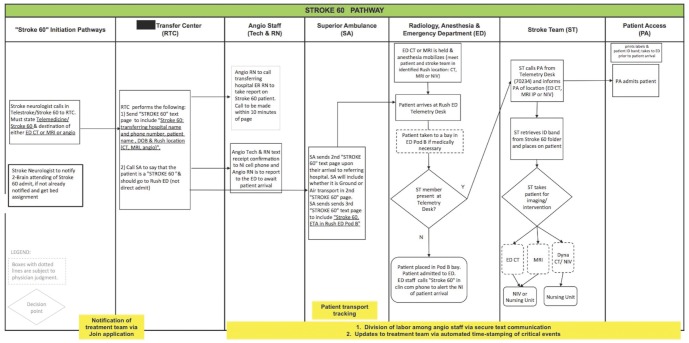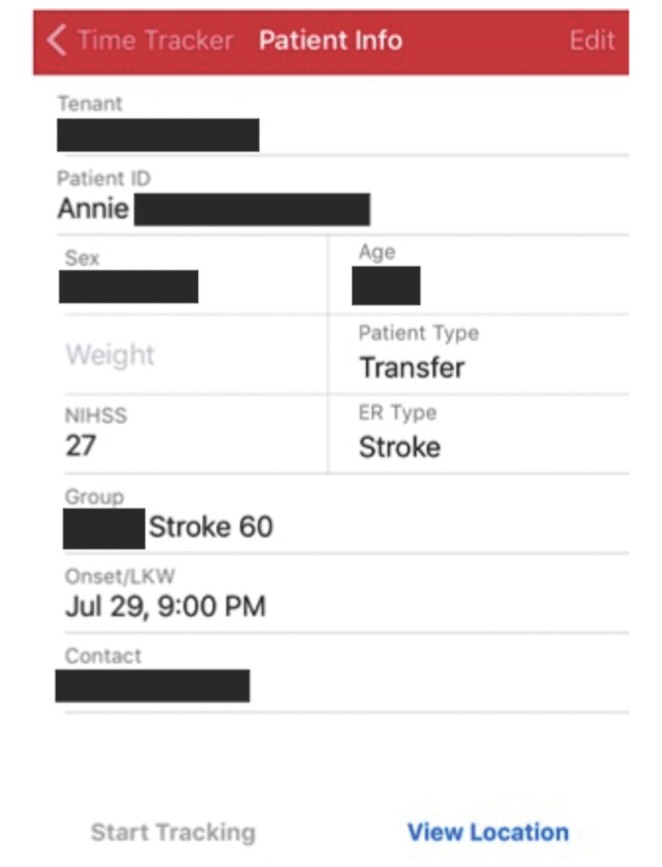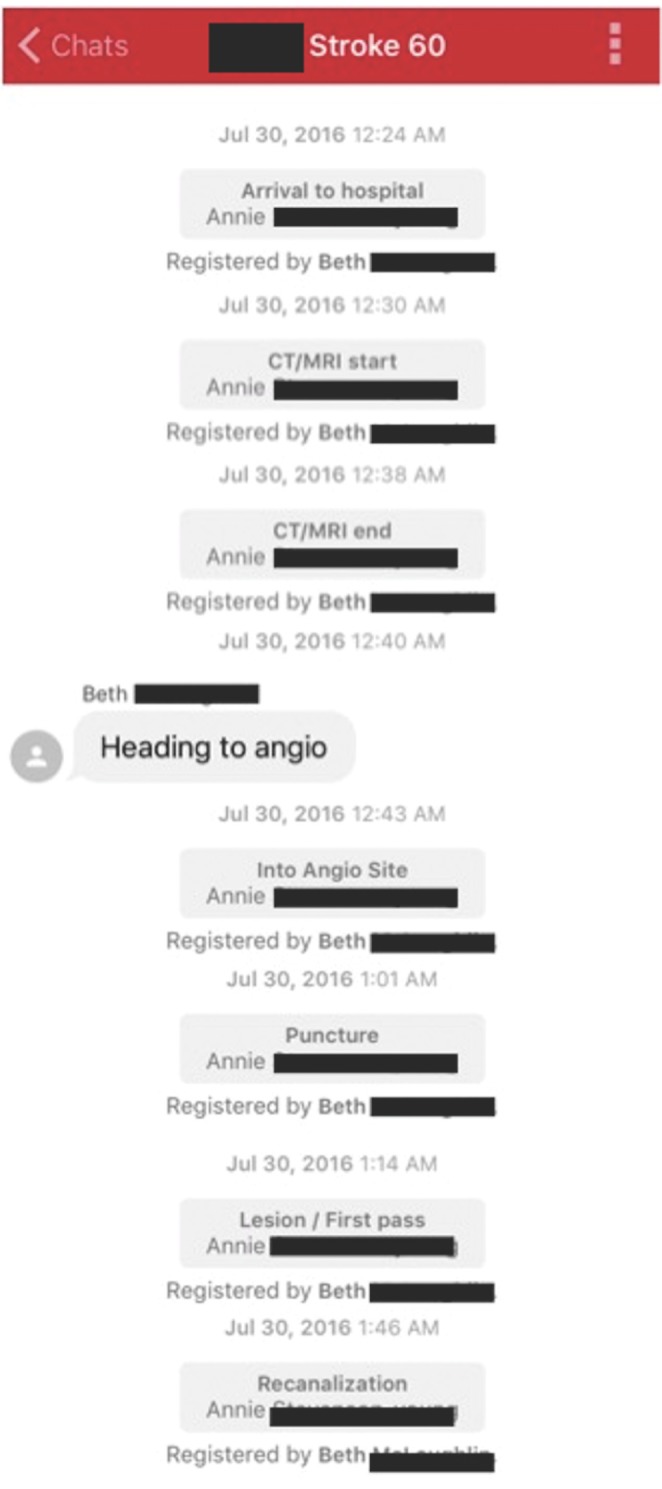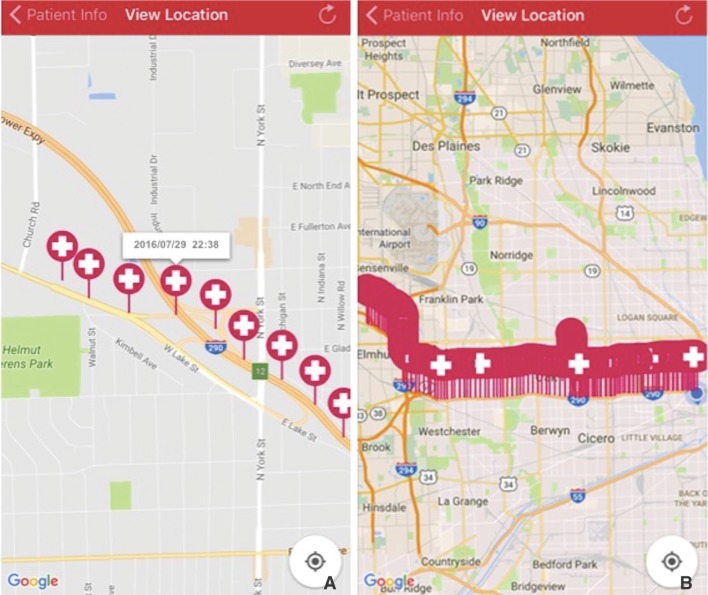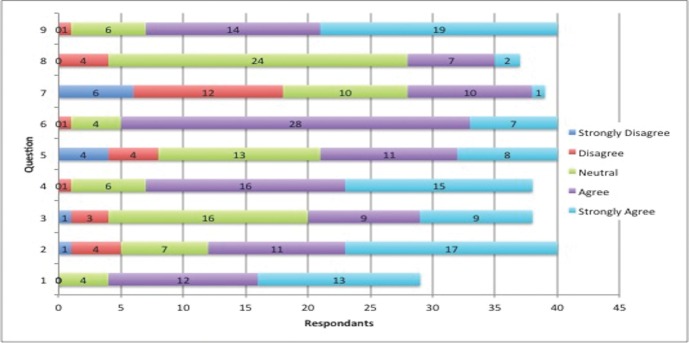Neurointervention.
2017 Sep;12(2):69-76. 10.5469/neuroint.2017.12.2.69.
Mobile Real-time Tracking of Acute Stroke Patients and Instant, Secure Inter-team Communication - the Join App
- Affiliations
-
- 1Department of Neurosurgery, Rush University Medical Center, Chicago, IL, USA.
- 2Department of Neurology, Rush University Medical Center, Chicago, IL, USA.
- KMID: 2389498
- DOI: http://doi.org/10.5469/neuroint.2017.12.2.69
Abstract
- PURPOSE
The primary correlate to survival and preservation of neurologic function in patients suffering from an acute ischemic stroke is time from symptom onset to initiation of therapy and reperfusion. Communication and coordination among members of the stroke team are essential to maximizing efficiency and subsequently early reperfusion. In this work, we aim to describe our preliminary experience using the Join mobile application as a means to improve interdisciplinary team communication and efficiency.
MATERIALS AND METHODS
We describe our pilot experience with the initiation of the Join mobile application between July 2015 and July 2016. With this application, a mobile beacon is transported with the patient on the ambulance. Transportation milestone timestamps and geographic coordinates are transmitted to the treating facility and instantly communicated to all treatment team members. The transport team / patient can be tracked en route to the treating facility.
RESULTS
During our pilot study, 62 patients were triaged and managed using the Join application. Automated time-stamping of critical events, geographic tracking of patient transport and summary documents were obtained for all patients. Treatment team members had an overall favorable impression of the Join application and recommended its continued use.
CONCLUSION
The Join application is one of several components of a multi-institutional, interdisciplinary effort to improve the treatment of patients with acute ischemic stroke. The ability of the treatment team to track patient transport and communicate with the transporting team may improve reperfusion time and, therefore, improve neurologic outcomes.
Keyword
Figure
Reference
-
1. Thomairy NA, Mummaneni M, Alsalamah SM, Moussa N, Coustasse A. Use of smartphones in hospitals. Health Care Manag (Frederick). 2015; 34:297–307. PMID: 26506291.
Article2. Cohen AB, Nahed B, Sheth KN. Mobile medical applicaitons in neurology. Neurol Clin Pract. 2013; 3:52–60.3. Seo WK, Kang J, Jeon M, Lee K, Lee S, Kim JH, et al. Feasibility of using a mobile application for the monitoring and management of stroke-associated risk factors. J Clin Neurol. 2015; 11:142–148. PMID: 25851892.
Article4. Widmer RJ, Collins NM, Collins CS, West CP, Lerman LO, Lerman A. Digital health interventions for the prevention of cardiovascular disease: a systematic review and meta-analysis. Mayo Clin Proc. 2015; 90:469–480. PMID: 25841251.
Article5. Demaerschalk BM, Vargas JE, Channer DD, Noble BN, Kiernan TE, Gleason EA, et al. Smartphone teleradiology application is successfully incorporated into a telestroke network environment. Stroke. 2012; 43:3098–3101. PMID: 22968466.
Article6. Gonzalez MA, Hanna N, Rodrigo ME, Satler LF, Waksman R. Reliability of prehospital real-time cellular video phone in assessing the simplified National Institutes Of Health Stroke Scale in patients with acute stroke: a novel telemedicine technology. Stroke. 2011; 42:1522–1527. PMID: 21512180.7. Cooray C, Matusevicius M, Wahlgren N, Ahmed N. Mobile Phone-Based Questionnaire for Assessing 3 Months Modified Rankin Score After Acute Stroke: A Pilot Study. Circ Cardiovasc Qual Outcomes. 2015; 8(6 Suppl 3):S125–S130. PMID: 26515200.8. Demaerschalk BM, Vegunta S, Vargas BB, Wu Q, Channer DD, Hentz JG. Reliability of real-time video smartphone for assessing National Institutes of Health Stroke Scale scores in acute stroke patients. Stroke. 2012; 43:3271–3277. PMID: 23160878.
Article9. Choi YH, Ku J, Lim H, Kim YH, Paik NJ. Mobile game-based virtual reality rehabilitation program for upper limb dysfunction after ischemic stroke. Restor Neurol Neurosci. 2016; 34:455–463. PMID: 27163250.
Article10. Zhang MW, Chew PY, Yeo LL, Ho RC. The untapped potential of smartphone sensors for stroke rehabilitation and after-care. Technol Health Care. 2016; 24:139–143. PMID: 26484884.
Article11. Nam HS, Heo J, Kim J, Kim YD, Song JJ, Park E, et al. Development of smartphone application that aids stroke screening and identifying nearby acute stroke care hospitals. Yonsei Med J. 2014; 55:25–29. PMID: 24339283.
Article12. Zendejas B, Ali SM, Huebner M, Farley DR. Handing over patient care: is it just the old broken telephone game? J Surg Educ. 2011; 68:465–471. PMID: 22000532.
Article13. Nishimura K, Nakamura F, Takegami M, Fukuhara S, Nakagawara J, Ogasawara K, et al. Cross-sectional survey of workload and burnout among Japanese physicians working in stroke care: the nationwide survey of acute stroke care capacity for proper designation of comprehensive stroke center in Japan (JASPECT) study. Circ Cardiovasc Qual Outcomes. 2014; 7:414–422. PMID: 24823957.
- Full Text Links
- Actions
-
Cited
- CITED
-
- Close
- Share
- Similar articles
-
- Smartphone App in Stroke Management: A Narrative Updated Review
- Automated Detection of Horizontal Strabismus and Home Control Evaluation Using a Mobile Phone App
- Facilitating Stroke Management using Modern Information Technology
- Moving anesthesiology educational resources to the point of care: experience with a pediatric anesthesia mobile app
- Prehospital Notification Using a Mobile Application Can Improve Regional Stroke Care System in a Metropolitan Area

